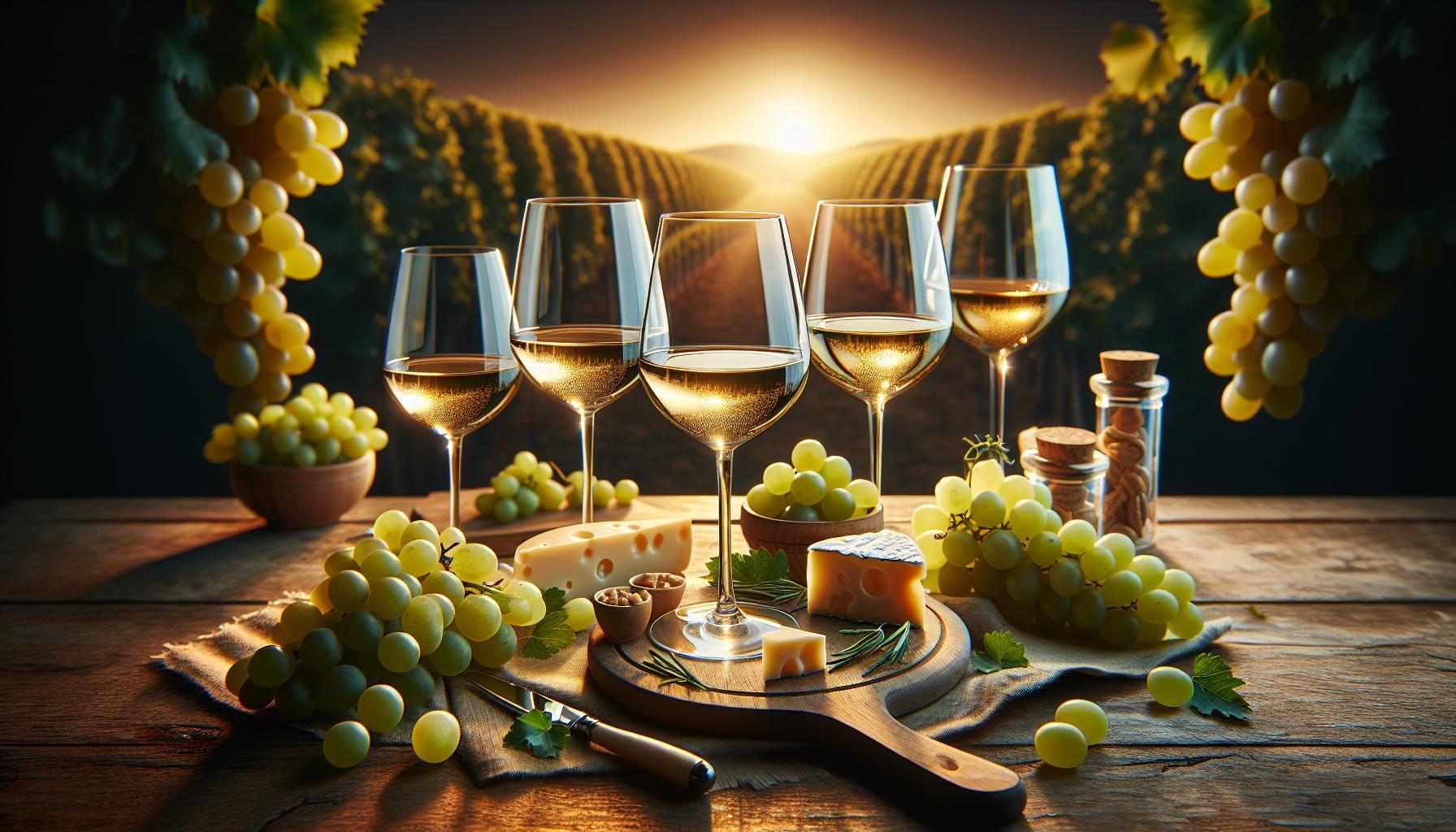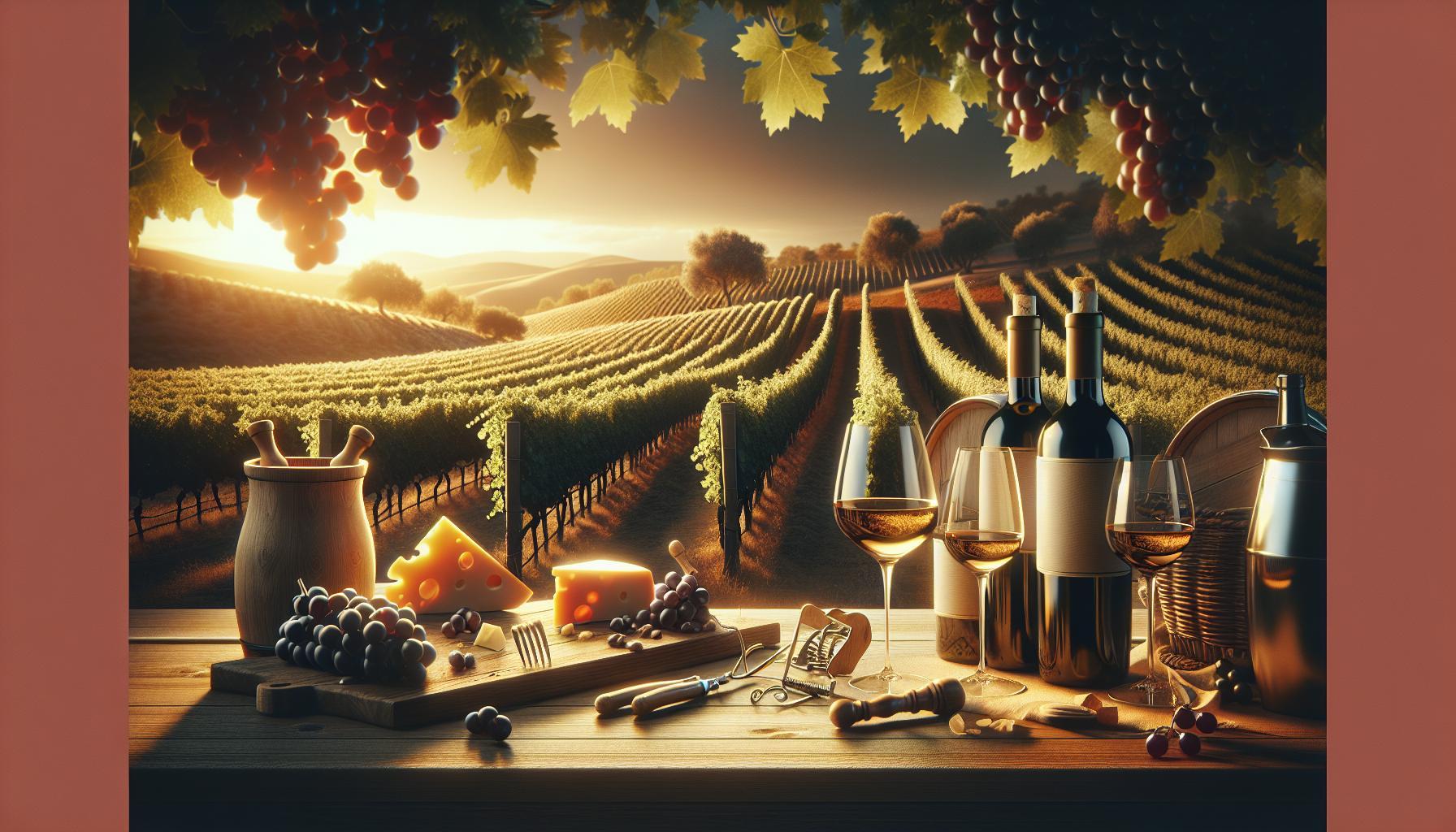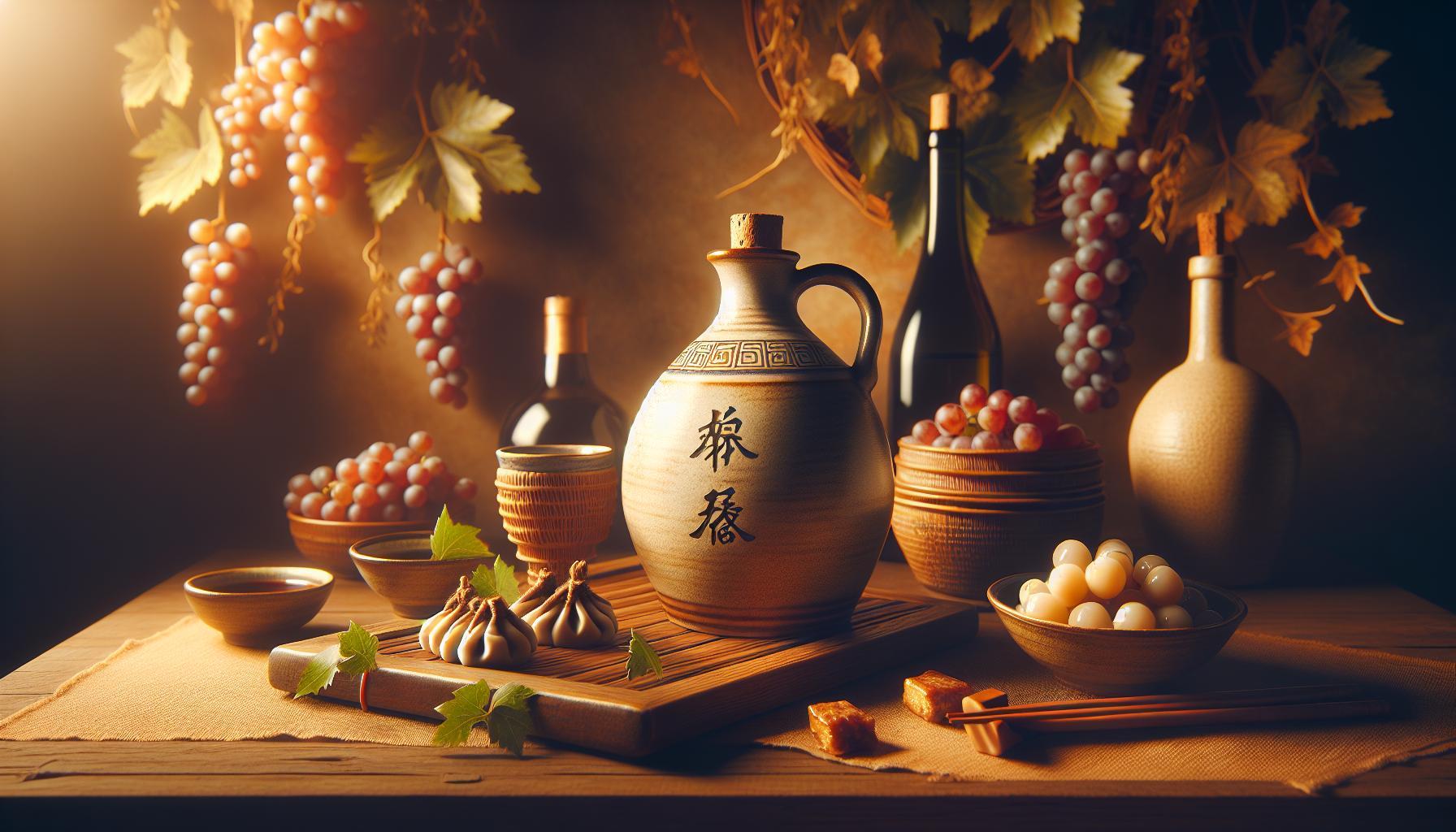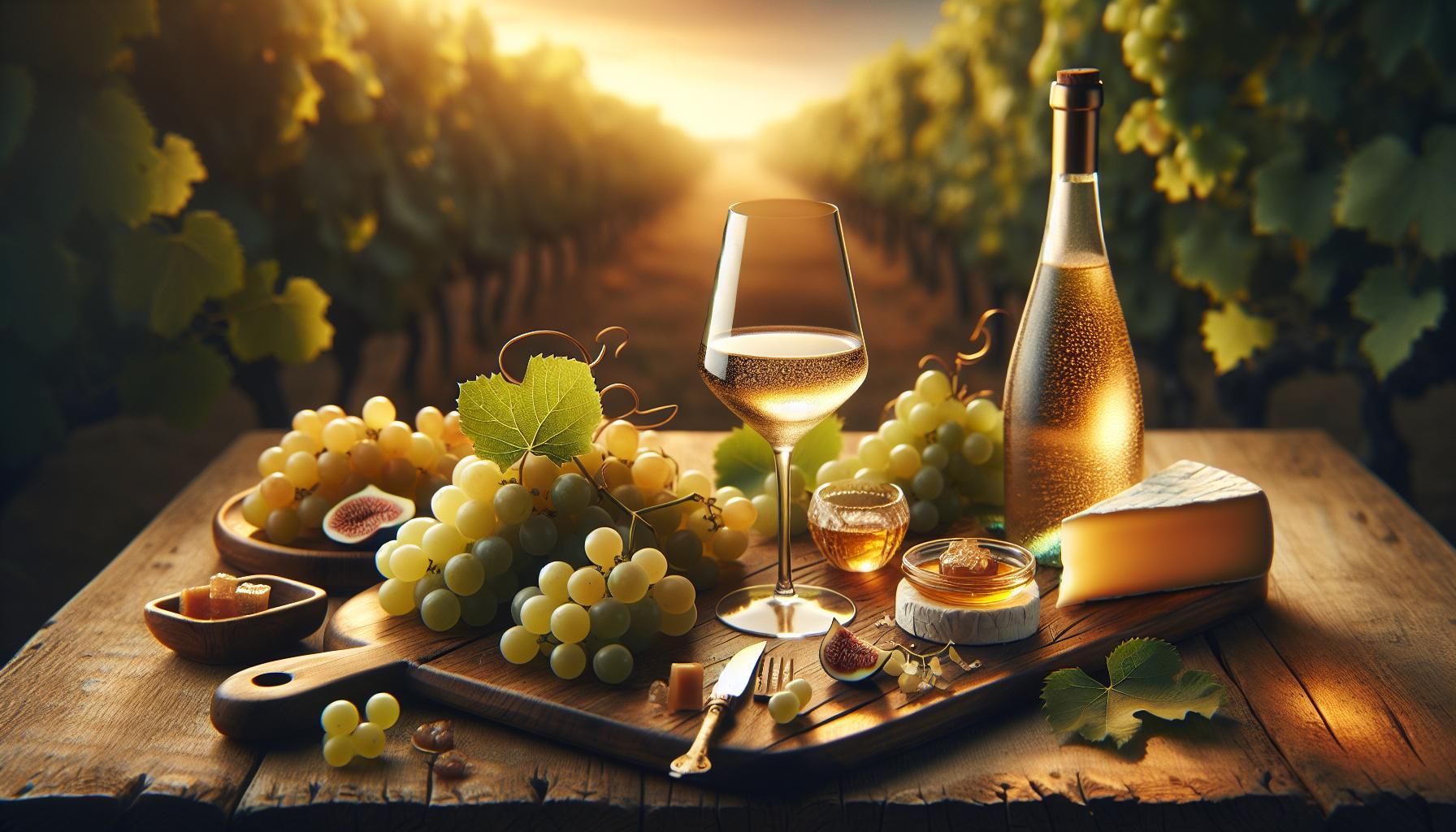White wine, with its myriad styles and flavors, can elevate any occasion, whether you’re planning a casual dinner with friends or hosting a formal gathering. It’s fascinating to think that just as grape varietals express the terroir of their origins, each bottle tells a unique story shaped by climate, culture, and tradition. Choosing the perfect white wine isn’t just about taste; it’s about creating memorable connections, enhancing your meal, and indulging your senses.
As you navigate the world of white wines, you may find yourself bewildered by the selections available. Fear not! This guide will unveil top picks that suit every palate and occasion, simplifying your decision-making process. From crisp Sauvignon Blancs to luxurious Chardonnays, there’s a delightful option waiting to be discovered for every moment. Dive in, explore, and let your taste buds embark on a splendid adventure!
Understanding White Wine Varieties and Styles
Wine lovers know that white wine is a wondrous tapestry of aromas and flavors, ranging from the zesty brightness of Sauvignon Blanc to the creamy comfort of Chardonnay. Each varietal tells a story rooted in its terroir-the unique combination of soil, climate, and tradition that shapes its character. Embracing the variety allows us to traverse the landscapes of the world from the green hills of Marlborough to the sun-drenched vineyards of California. deepens our appreciation and enhances our ability to select the ideal bottle for any occasion.
Exploring the Varieties
At the core of white wine’s allure is its remarkable diversity. Popular varietals like Chardonnay, with its buttery notes and hints of tropical fruit, can vary dramatically depending on whether it’s been oak-aged or stainless steel fermented. On the other hand, Riesling can be delightfully sweet or bone dry, showcasing a spectrum that dances between floral nuances and crisp minerality. As you navigate this world, consider also lesser-known varieties like Viognier, characterized by its lush stone fruit profile, or Albariño, which bursts with citrus and salinity, perfect for seafood pairings.
The Styles of White Wine
Beyond the varietal distinction lies the style of the wine, which often reflects its production methods. For example, many wines undergo malolactic fermentation, a process that softens the acidity and adds creaminess-ideal for those who enjoy a rich mouthfeel in their glass. Still, other wines, particularly those from cooler climates, retain sharper acidity, offering a lively, refreshing sip perfect for warm days. Exploring these subtleties not only enriches your palate but also encourages thoughtful conversation about each wine’s journey from vineyard to glass.
Understanding these varietals and styles becomes an invitation to explore pairings that elevate meals and delight guests. Whether you’re hosting a dinner party or enjoying a quiet evening, the more you know about white wine, the more interesting your choices become-transforming each sip into a narrative filled with history, culture, and personal connection. So, pour a glass, take a moment to inhale the aromas, and let the story unfold on your palate.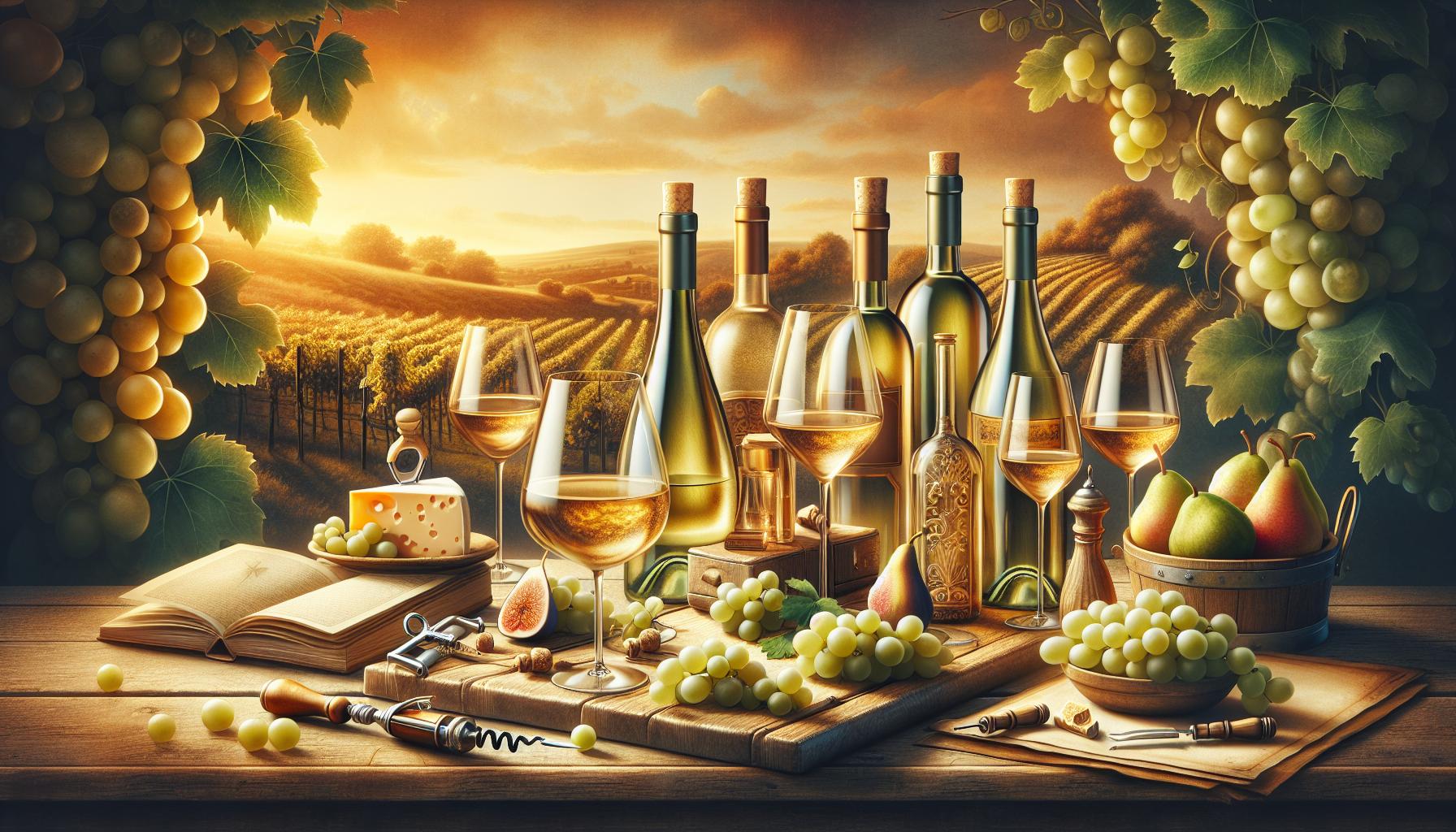
The Art of Tasting: How to Savor White Wine
The act of savoring white wine is akin to a gentle exploration of both the senses and the soul. When you pour a glass and take the time to appreciate what lies within, you’re not just consuming a beverage; you are engaging with a rich tapestry of flavors, aromas, and stories that span vineyards and generations. To fully immerse yourself in the experience, begin with a mindful observation. As you hold your glass up to the light, note the color-whether it’s the pale straw hue of a crisp Sauvignon Blanc or the golden glow of an aged Chardonnay. Each shade offers a glimpse into the wine’s journey and character.
Once you’ve observed the visual cues, the next step is to indulge your sense of smell. Swirl the wine gently in your glass to release its aromas, which can range from floral and fruity to earthy and oaky depending on the varietal and winemaking process. Close your eyes and take a deep breath, letting the scents transport you. You might detect hints of ripe pear, zesty citrus, or even a whisper of vanilla. These olfactory notes set the stage for what’s to come. It’s a moment of connection, bridging the gap between the bottle and your experience, inviting you deeper into the wine’s story.
As you finally take your first sip, let it linger on your palate. Take note of the wine’s acidity, sweetness, and body. A light, zesty wine like a Pinot Grigio will tickle your taste buds differently than a full-bodied, buttery Chardonnay might envelop them. Allow the wine to roll over your tongue, and notice the layers of flavor that unfold. This is where the magic truly happens; the interplay of different taste sensations can spark memories or inspire new ones, making each tasting a unique experience. Reflect on how the wine evolves as it leaves your mouth-does it finish crisp and clean, or does it linger luxuriously?
To enhance your tasting journey, consider the context in which you’re enjoying your wine. Pair it with food that complements its profile-perhaps a light seafood dish with a Sauvignon Blanc or a rich pasta in cream sauce with a Chardonnay. The synergy created between the wine and food can elevate both experiences to new heights. Ultimately, savoring white wine is not merely about taste; it’s about cultivating an appreciation for the intricacies of each glass, celebrating the craftsmanship behind it, and sharing stories and moments that make every sip memorable.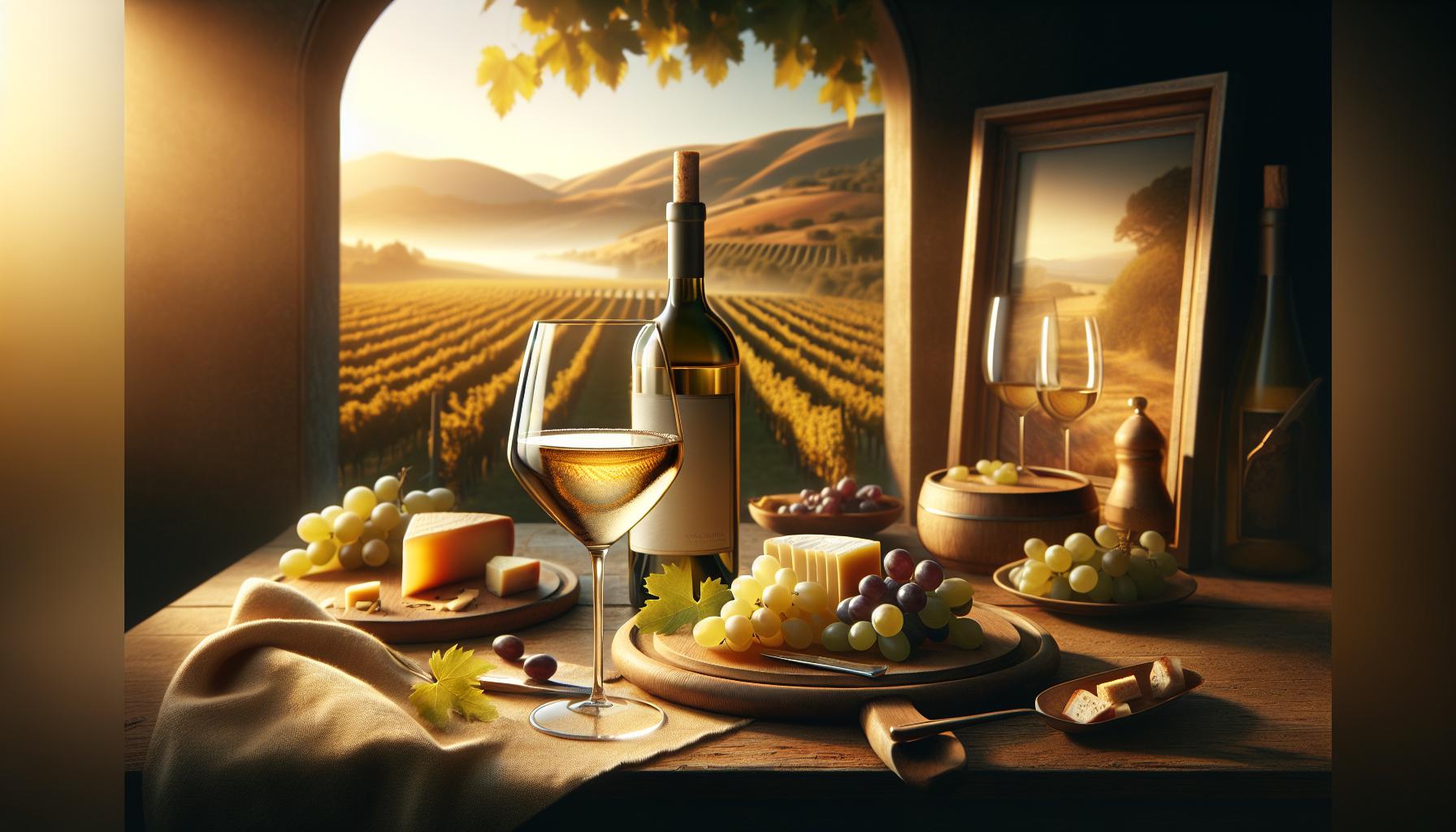
Food Pairings: Elevating Meals with White Wine
The right white wine can transform an ordinary meal into an extraordinary dining experience, lifting flavors and creating harmonious pairings that delight the palate. Whether hosting an intimate dinner or a festive gathering, understanding how to pair white wine with food opens up a world of culinary possibilities. Picture a crisp Chardonnay, its buttery notes perfectly complementing a rich lobster dish, or a zesty Sauvignon Blanc enhancing a fresh summer salad. These magical pairings are not merely coincidences-they’re grounded in the wine’s inherent characteristics and the nuanced flavors of the dishes they accompany.
Classic Pairings to Explore
- Chardonnay: Ideal for richer foods, this versatile wine shines alongside creamy sauces and roasted poultry. The wine’s buttery texture and notes of apple or pear can wonderfully balance dishes like chicken Alfredo or a decadent lobster risotto.
- Sauvignon Blanc: Its high acidity makes it a fantastic match for zesty flavors. Enjoy it with dishes that feature citrus, like a lemon herb chicken or a vibrant goat cheese salad, where its sharpness enhances the freshness of the ingredients.
- Riesling: With its sweetness and floral notes, Riesling pairs beautifully with spicy cuisine. Think Thai green curry or spicy Szechuan dishes-this wine can quell the heat while emphasizing the intricate flavors of the food.
- Pinot Grigio: Light and refreshing, this wine works well with light fare such as seafood, particularly grilled fish or shrimp tacos. Here, the subtle notes of stone fruit in the wine can accentuate the sweetness of the seafood.
To further elevate your dining experience, consider the weight of the dish compared to the wine. Lighter dishes tend to harmonize better with lighter wines, while fuller-bodied wines pair well with heartier meals. Remember, too, that the experience of tasting is both subjective and influenced by personal preference, so don’t hesitate to experiment with unconventional pairings that speak to your own palate.
The Power of Synergy
When wine and food come together, they create a synergy that can enhance both elements exponentially. For instance, a vibrant Riesling can bring out the subtle sweetness of a miso-glazed salmon, while a full-bodied Viognier may intensify the aromatic spices in Moroccan chicken. The key lies in finding the balance-seeking flavors that either complement or contrast beautifully. In essence, each pairing offers a new narrative, taking you on a sensory journey that reflects both the terroir of the wine and the essence of the meal.
So next time you find yourself pondering which white wine to serve, remember that the journey of pairing is as enriching as the act of savoring itself. Allow your palate the adventure of discovery, and be open to the narratives that unfold from every glass and plate. Celebrate the art of making connections, not just between flavors, but also between people and stories shared over a beautiful meal, enhanced by a perfect pour.
Choosing White Wine for Special Occasions
Selecting the perfect white wine for a special occasion can elevate a celebration from ordinary to extraordinary, transforming a simple gathering into an unforgettable experience. The art of choosing wine lies not just in the varietals themselves, but in understanding how each wine interacts with the mood, the food, and the company present. Whether it’s a wedding, anniversary, or a cozy dinner with friends, the right bottle can spark joy and invite conversation, turning each sip into a cherished memory.
When considering a celebratory toast or a meal that deserves a touch of elegance, one might gravitate towards notable varietals such as Chardonnay, often heralded for its versatility. This wine can adapt to many palates, from the rich, buttery styles that complement a lavish lobster dish to the more mineral-driven options that pair seamlessly with delicate white fish. For outdoor summer soirées, a chilled Sauvignon Blanc can bring a refreshing zest that dances on the tongue, perfectly matched with grilled vegetables or light salads adorned with citrus dressings.
Moreover, don’t shy away from exploring Riesling, especially if the festivities include spicy cuisines or lighter fare. Its natural sweetness and acidity make it an excellent companion for foods with a pinch of heat, providing a delightful contrast that excites the palate. In contrast, if the occasion calls for something bubbly, Sparkling Wine or a classic Champagne provides an effervescent touch that channels celebration itself. Picture the fizz as you pop the cork, releasing aromas of citrus and toast, inviting all present to share in a moment of pure joy.
Ultimately, the best choice integrates thoughtful selection with personal stories. Perhaps a wine that echoes a shared vacation in Napa Valley or one that reminds you of celebrations past with loved ones. As you navigate your options, reflect on what resonates with your audience and the flavors that will complement the fare you’re serving. Crafting the perfect pairing isn’t merely about taste-it’s about creating connections through shared experiences, and every glass serves as a vessel for dialogue, laughter, and life’s memorable moments.
Sparkling Whites vs. Still Whites: What’s the Difference?
The effervescence of sparkling whites dances on the palate, lending a festive flair that still whites seldom replicate. While both categories hail from the beloved grape family, their fundamental differences shape not just flavor profiles but also the occasions for which they’re best suited. At the core of their divergence is the method of production. Sparkling wines undergo a secondary fermentation process, often in the bottle, which captures carbon dioxide and creates those enchanting bubbles that tingle as they meet your lips. The classic Champagne method, or méthode champenoise, is renowned for producing refined sparkling wines, with intricate aromas that can encompass everything from brioche to fresh fruit. Meanwhile, still whites, devoid of bubbles, showcase the purity of their grape origins, allowing a clearer expression of terroir and varietal character.
When it comes to pairing with food or setting a mood, the choices between these two categories become equally fascinating. Sparkling whites, such as Prosecco or Cava, often bring a zesty acidity and a touch of sweetness, making them incredibly versatile. They excel with salty appetizers, fried dishes, and even creamy desserts, where the bubbles can cut through richness and enhance contrasting flavors. Consider a lively Asti Spumante with a fruit tart; the sweetness harmonizes beautifully, creating a delightful balance that wows guests at celebrations.
In contrast, still whites like Sauvignon Blanc or Chardonnay lend themselves to more nuanced pairings. A crisp Sauvignon Blanc shines alongside fresh seafood or herbed salads, elevating seasonal ingredients to their fullest potential. The rich, oaked Chardonnays, with their buttery undertones, beautifully complement roasted chicken or a creamy risotto, enveloping meals in a comforting embrace. Each type speaks to different moments in our lives; sparkling whites usher in celebrations and playful gatherings, while still whites often accompany intimate dinners or reflective evenings.
The choice between sparkling and still is ultimately a matter of personal preference, and perhaps even circumstance. Reflecting on your own experiences-are you yearning for the effervescent joy captured in a sparkling toast, or the serene depth found in a glass of still goodness? As you explore these two captivating worlds, allow your palate and the context of your gathering to guide you towards the perfect pour. Each sip, whether bubbly or smooth, serves as a reminder that wine is more than just a beverage; it’s a means of connection, celebration, and endless discovery.
Regions That Define Exceptional White Wine
In the world of white wine, certain regions stand out not only for their production but also for the unique characteristics they impart to the grapes. Each area, with its own climate, soil, and winemaking traditions, crafts wines that tell stories of their origins. Consider, for instance, California’s Napa Valley, where the warm days and cool nights create a microclimate perfect for growing rich, full-bodied Chardonnays and vibrant Sauvignon Blancs. Here, the sun blesses the grapes with ripeness, while the cooler evenings help preserve the acidity-resulting in wines that are both lush and refreshing.
Moving across the Atlantic, the Loire Valley in France is a treasure trove of white wine styles. Known for its crisp and aromatic whites, this region produces everything from the mineral-driven Sancerre, made from Sauvignon Blanc, to the lush, fruit-forward Vouvray, primarily crafted from Chenin Blanc. The diverse terroirs-ranging from chalky soils to flint-infuse these wines with complex flavors that reflect the uniqueness of their environment. When sipping a chilled glass of Sancerre, one can almost visualize the rolling vineyards bathed in the gentle Loire sunlight.
- Riesling from Germany: Not to be overlooked, the Mosel region is famed for its Rieslings, which can range from bone-dry to lusciously sweet. The steep, slate-covered hillsides enhance the grape’s acidity and aromatic profile, producing wines that can age gracefully for decades.
- Pinot Grigio from Italy: In the northeastern regions of Friuli and Veneto, Pinot Grigio shines with its crispness and refreshing acidity, often featuring bright notes of green apple and pear. These wines embody the essence of Italian sunny days and pair beautifully with seafood and light pasta dishes.
- Chenin Blanc from South Africa: A vibrant new player on the world stage, South Africa’s Chenin Blanc exhibits a versatile character, from dry, zesty styles to sweet, aromatic dessert wines. The country’s diverse climate allows for a broad spectrum of expressions, making it a must-try for adventurous wine enthusiasts.
As you explore the diverse s, remember that the terroir-essentially, the environment in which the grapes are grown-deeply influences the final product. The interplay of climate, soil, and local practices unlocks a spectrum of flavors and aromas that can transport you to the sun-drenched vineyards or misty riverbanks where the grapes flourished. So next time you pour a glass, allow the nuances of its origin to enhance your experience, each sip becoming a lovely exploration of the world’s celebrated wine regions.
Budget-Friendly White Wines That Impress
Sure, here is the content for the section on budget-friendly white wines:
In the world of wine, the myth that great quality comes only at a steep price is one that continually warrants debunking. Budget-friendly white wines can be a delightful discovery, opening doors to bold flavors and enjoyable experiences without straining your wallet. Picture yourself enjoying a glass of wine that feels luxurious and sophisticated, yet was achieved without the celebratory bill at the end of the night. This is absolutely possible, so let’s explore some delightful options that impress without making your credit card weep.
First on our list is Albarino, a versatile Spanish varietal that boasts vibrant citrus notes and a refreshing minerality. Hailing from the Rías Baixas region, this wine pairs marvelously with seafood, enhancing flavors of fresh oysters or grilled fish. With quality bottles often priced around $15, Albarino is a fantastic choice for summer picnics or casual gatherings, ensuring your guests feel pampered. If you’re seeking something with a bit more body, try a Vinho Verde from Portugal. Known for its lightness and slight effervescence, it offers a delightful twist with flavors reminiscent of green apples and lime, typically available for under $10.
Chenin Blanc: Diversity on a Budget
Another fantastic yet often underrated option rests in the heart of South Africa: Chenin Blanc. This wine can manifest itself in various styles, ranging from dry to sweet, often embodying tropical fruit notes blended with a crisp acidity. A bottle can frequently be found for less than $15. South African Chenin Blanc has gained recognition for its complexity and depth, making it a compelling choice for both casual sips and formal dinners alike. Whether enjoyed alongside a rich curry or a charcuterie board, its versatility sings with every sip, and it’s a delight to share with friends.
Pairing budget-conscious wines with delectable meals only enhances their appeal. Opt for a Sauvignon Blanc from New Zealand, which typically showcases bright acidity and notes of passionfruit and fresh herbs. These wines often retail for around $12, making them a fantastic choice for pairing with Thai or spicy Asian dishes, allowing the wine’s crisp nature to balance the heat beautifully. For those who appreciate a hint of sweetness, some of the best Rieslings can be found at astonishingly reasonable prices, offering a delightful balance of fruit-forward sweetness and zesty acidity.
By venturing into the world of affordable white wines, you simultaneously open yourself up to new experiences and flavors while boosting your confidence as a wine enthusiast. Each selection tells a story, linked to the land and produce from which it originates. So go ahead, explore these treasures that don’t break the bank, and savor every moment as you pour, sip, and discover richer layers of taste without the pretense often associated with fine wines. Embrace the joy of sharing cheaper yet high-quality bottles with friends, and relish in your newfound ability to impress while staying within a budget.
Sustainable and Organic White Wines to Consider
In recent years, the appeal of sustainable and organic white wines has surged, reflecting a growing awareness among consumers about the environmental impact of viticulture. These wines not only boast remarkable flavors but also come from vineyards operated with practices that respect the earth, emphasizing biodiversity and reducing chemical input. Imagine savoring a vibrant bottle of organic Sauvignon Blanc that embodies the purity of its terroir, all while knowing that your choice contributes positively to the planet. This intersection of enjoyment and sustainability offers a rewarding experience for conscientious wine lovers.
One prominent example is the Napa Valley’s organic Chardonnay, which showcases the region’s unique terroir. Many Napa winemakers are adopting organic practices, allowing grapes to mature naturally without synthetic pesticides. This approach not only enhances the wine’s flavor profile-think crisp green apple and refreshing citrus-but also supports local ecosystems and health. Another intriguing choice is Albarino from sustainable vineyards in the Rías Baixas region of Spain. Known for its zesty notes of peach and briny minerality, this wine pairs beautifully with seafood, encapsulating a sense of place while adhering to sustainable farming methods.
Looking beyond the traditional choices, consider exploring lesser-known varietals that excel under organic cultivation. Grüner Veltliner, a vibrant white from Austria, thrives in organic vineyards and is appreciated for its peppery notes and green apple freshness. This versatile wine opens a delightful avenue for pairing with diverse dishes, from spring vegetables to creamy pastas. Meanwhile, the Verdejo grape from Rueda offers a rich tapestry of tropical fruits and herbal undertones, typically bottled with minimal intervention, allowing the winemaker’s philosophy and the grape’s character to shine through.
For those eager to embrace sustainability without compromising on quality, there are numerous certifications to look for on the bottle. These can range from “Organic Certified” to “Biodynamic,” which adheres to even stricter ecological standards. By choosing wines with these labels, you not only elevate your palate but also contribute to sustainable agricultural practices that enhance biodiversity and soil health. The next time you find yourself browsing the wine aisle, remember that the right choice can be both a culinary delight and a responsible decision for our planet.
Decoding Wine Labels: What to Look For
Understanding the intricacies of wine labels can transform your wine selection from a mundane task into an exciting journey of discovery. Every label offers a glimpse into the story behind the wine, providing valuable information that speaks to its origin, production methods, and flavors waiting to be explored. For those wishing to navigate the world of white wines with confidence, familiarizing yourself with these details can truly enhance your experience, ensure pleasant pairings, and help you choose the perfect bottle for any occasion.
First, pay attention to the varietal listed on the label. This indicates the type of grape used, and each varietal-be it Sauvignon Blanc, Chardonnay, or Riesling-carries its unique flavor profile, aromas, and typical characteristics. For instance, Sauvignon Blanc often bursts with zesty citrus and green herb notes, making it a delightful companion to seafood or fresh salads. Conversely, a creamy Chardonnay can exude buttery flavors that perfectly complement rich pasta dishes. Understanding these nuances allows you to align your wine choices with specific cuisine or occasion, fostering memorable dining experiences.
Next, consider the wine’s origin, often indicated by the region or specific vineyard. Terms like “Old World” (referring to Europe) and “New World” (like the USA, Australia) connote different winemaking philosophies and traits. Old World wines might offer earthier, more subdued flavors, while New World counterparts often yield more fruit-forward, intense profiles. A bottle from Burgundy may intrigue with its complex terroir, hinting at the specific environmental factors that shaped its character, while a Napa Valley selection could indulge with straightforward fruit expression, thanks to the warm climate and innovative viticulture.
Additionally, certificates or designations regarding organic and sustainable practices-like “Organic Certified” or “Biodynamic”-offer insights into the methods employed in the vineyard. Wines bearing such labels not only reflect a commitment to environmental stewardship but often have unique taste profiles that showcase the pure expression of their terroir. Seeking out these organic varieties means supporting responsible practices while indulging in wines that often carry less chemical burden, enhancing your experience on multiple levels.
Finally, don’t overlook vintage-the year the grapes were harvested. This detail hints at the climatic conditions that year and how they may have influenced the wine’s quality and taste. A particularly hot year might yield a bolder wine, while cooler years may produce something more delicate and nuanced. Researching vintage quality for specific regions can guide your purchases, ensuring that you’re not only drinking well but also embracing the serendipity of geography and weather in every pour.
By honing your skills in decoding wine labels, you engage more deeply with each bottle you choose. With every outing to your local wine shop or the expansive aisles of a supermarket, you can now approach each label not just as a marker of ingredients, but as an invitation to explore stories of the land, seasons, and the artisans behind your next white wine delight.
Aging White Wine: Myths and Realities
When considering the aging potential of white wine, it’s essential to peel back the layers of myth surrounding this nuanced subject. Contrary to the belief that all wines improve with age, white wines often tell a different story. While some may benefit from a few years of maturation, many white wines are best enjoyed when they are young, fresh, and vibrant. With their crisp acidity and fragrant notes, wines like Sauvignon Blanc and Pinot Grigio shine brightly in their youth, captivating palates with bursts of citrus and herbal undertones. Storing these wines for years may mute their lively character, leaving you with a lackluster sip that fails to excite the senses.
However, this does not mean that all white wines lack the ability to age gracefully. Certain styles, such as creamy Chardonnays and aromatic white blends, can indeed evolve into complex, layered experiences over time. The presence of higher acidity and residual sugar can create a structure that allows these wines to develop intriguing tertiary flavors-think of those lovely hints of honey, nuts, or even savory notes reminiscent of roasted herbs. Notable examples include certain white Burgundy wines, which can age for a decade or more, unfurling their intricate bouquet with each passing year. By understanding the right varietals and their aging potentials, you can curate a collection that surprises and delights as time progresses.
Temperature and storage conditions also play a pivotal role in a wine’s aging potential. Unlike red wines that can withstand higher temperatures, white wines benefit from consistent, cooler environments. A temperature range of 45°F to 55°F (7°C to 13°C) is optimal to preserve their freshness and avoid premature aging. A well-maintained cellar or a specialized wine fridge can help achieve this environment, ensuring that your chosen whites-the ones suited for aging-transform beautifully rather than spoil. Remember, too, that the closure of the bottle has implications: corks allow for slow oxygen exchange, a crucial factor for aging, while synthetic closures may not afford the same benefits.
In summary, while many myths surround the aging of white wine, understanding the realities can enhance your wine journey. Embrace the vibrancy of young whites, but don’t dismiss the beauty of select aging varieties. Select the right bottles, store them carefully, and allow them the time they need to reveal their stories-each glass a testament to the passage of time and the artistry behind the craft. As you explore the dynamic world of white wine, consider age not just as a number but as an experience waiting to unfold, rich with flavor and depth, inviting you to linger in the moment and savor every subtle nuance.
Exploring Unique White Wine Grapes and Their Profiles
The world of white wine grapes is a treasure trove waiting to be explored, each variety a unique expression of its terroir, history, and winemaking traditions. For instance, consider the iconic Chardonnay, a grape that embodies versatility. From the crisp, mineral-driven Chardonnays of Chablis, where each sip whispers tales of limestone and cool climates, to the opulent, oaked versions from California, where lush layers of butter and vanilla create a decadent experience. The beauty of Chardonnay lies not just in its wide range but in its transformative ability when blended with oak or left pristine and unoaked, offering wine lovers a delightful spectrum to choose from.
Discovering Distinctive Varietals
Venturing beyond the familiar, we encounter the charming Grüner Veltliner, Austria’s flagship white grape, known for its peppery notes and zesty lime aromas. This grape is a perfect companion to a variety of foods, from spicy Asian dishes to fresh seafood, showcasing how the right wine can elevate a meal effortlessly. Another fascinating contender is the Albariño from Spain’s Rías Baixas region, celebrated for its bright acidity and hints of stone fruit and sea breeze, rendering it a refreshing choice for summer picnics or outdoor gatherings. Its aromatic profile captures the essence of coastal living, often evoking the gentle waves of the Atlantic.
Navigating the Lesser-Known Gems
Don’t overlook the ability of less heralded grapes like Fiano or Verdicchio to surprise and delight. Fiano, hailing from southern Italy, offers a rich texture and aromas of honey, nuts, and tropical fruits, making it a wonderful match for roasted meats or creamy pastas. Meanwhile, Verdicchio, known for its crispness and mineral undertones, carries a distinctive almond note, creating a delightful pairing with oily fish or risottos. These unique varietals invite exploration, each bottle a passport to new culinary experiences and cultural stories.
In the journey through white wine grapes, remember that personal preferences can guide your selections. Whether you seek the lushness of a Viognier or the delicate crispness of a Sauvignon Blanc, each choice is a step into a broader narrative of flavor, tradition, and the artistry of winemaking. As you savor these wines, take a moment to appreciate the artistry behind each varietal-an adventure not merely in taste but in the stories they tell and the connections they foster around the table.
White Wine Cocktails: Creative Ways to Enjoy
Elevating the experience of white wine can often be as simple as transforming it into a delightful cocktail. Imagine a balmy evening where a crisp Sauvignon Blanc mingles with fresh fruits, herbs, or even spices, thereby transforming a classic beverage into a refreshing concoction that excites the palate. Crafting cocktails from white wine is not merely about mixing; it’s about enhancing wine’s inherent qualities, embracing its versatility, and inviting creativity into your glass.
One popular option is white wine sangria, a vibrant and convivial drink perfect for gatherings. Begin with a base of a dry white wine, such as Pinot Grigio or Verdejo, and add your choice of seasonal fruits-think sliced peaches, juicy strawberries, or zesty citrus. A splash of brandy or a liqueur like elderflower not only infuses delightful depth but adds an aromatic allure that enchants anyone within its vicinity. The beauty of sangria lies in its adaptability; you can adjust sweetness and acidity with a dash of soda water or sparkling wine, ensuring it resonates with your guests’ preferences.
To venture beyond sangria, consider exploring sophisticated cocktails like a refreshing Ginger and Lemon White Wine Cocktail. This invigorating mix combines the zestiness of lemon juice, the warming note of ginger, and the crispness of wine, creating a medley that invigorates the senses. Pairing the right wine-such as an Apothic White-ensures that the flavors harmonize beautifully, enhancing the drink’s overall profile. This cocktail embodies how you can layer flavors to create a complex, refreshing experience while keeping the ingredients simple.
Moreover, don’t overlook classic tangy spritzes like a White Wine Spritzer. Combining white wine with sparkling water and a hint of flavored syrup or fresh herbs adds a buoyancy and a dash of flair. The effervescence lifts the wine’s intrinsic fruity notes, making it an alluring choice for warm afternoons. It’s an easy way to incorporate white wine into leisurely sunny afternoons or festive brunches, highlighting its approachable versatility while keeping the mood light and enjoyable.
Ultimately, creating white wine cocktails invites an exploration of flavors and textures while celebrating the remarkable qualities of each varietal. Each glass tells a story-of the vineyards, the grapes, and the joys of social connection. So, as you venture into crafting your white wine cocktails, allow your imagination to guide you and discover the endless possibilities that await!
Frequently Asked Questions
Q: What are the characteristics of a good white wine?
A: A good white wine typically exhibits balance, clarity, and complexity. It should have a refreshing acidity, well-defined fruit flavors, and subtle notes of minerals or herbs. Consider varietals like Sauvignon Blanc for crispness or Chardonnay for richness. Explore these characteristics further in the full article on wine selection.
Q: Which white wines are best for pairing with seafood?
A: For seafood, white wines such as Pinot Grigio and Sauvignon Blanc are superb choices due to their acidity and lightness. They complement the flavors of fish and shellfish without overpowering them, enhancing the dining experience. Check out our section on food pairings for more insights.
Q: How do I choose a white wine for a specific occasion?
A: Choosing a white wine depends on factors like the menu, season, and mood. Light wines, like Vinho Verde, suit summer gatherings, while richer options, like oaked Chardonnay, are excellent for winter meals. Refer to our guide for tailored recommendations based on occasion.
Q: What is the difference between oaked and unoaked white wine?
A: Oaked white wine is aged in barrels, imparting flavors of vanilla and baking spices, while unoaked wines are fresher, showcasing pure fruit characteristics. This distinction can influence your choice depending on whether you prefer richness or bright acidity. Explore our tasting notes section for details.
Q: Can white wine improve with age?
A: While most white wines are best enjoyed young, certain varietals, such as high-quality white Burgundies or Rieslings, can benefit from aging. Look for wines with good acidity and structure to experience the depth that time can bring. Discover more about aging wine in our article.
Q: What white wines are ideal for a summer picnic?
A: For a summer picnic, consider light and refreshing wines such as Albariño or sparkling Rosé. These options are easy to sip and pair wonderfully with light foods like salads and cheeses. Check our picnic pairing guide for more suggestions.
Q: What white wines pair well with spicy food?
A: Off-dry white wines, like Riesling or Gewürztraminer, work beautifully with spicy dishes, as their sweetness helps to balance heat. These wines enhance the flavor without overwhelming the palate. For more recommendations on food pairings, refer to our section on taste profiles.
Q: How can I serve white wine properly?
A: To serve white wine correctly, chill it to the appropriate temperature-generally between 45-55°F. Use appropriate glassware to enhance the aromas and flavors. Explore our serving tips for detailed guidance on maximizing your white wine experience.
In Summary
As we uncork this exploration of white wine, you’re now equipped with selections that cater to every occasion, from the crisp brightness of a Sauvignon Blanc to the luxurious depth of an oaked Chardonnay. Remember, wine tasting is not just about the flavors; it’s a journey through vineyards and vintages, a celebration of culture and connection. So, why wait? Your next unforgettable bottle is just a click away.
To deepen your knowledge, check out our guides on food pairings and the fascinating world of wine regions, where you’ll uncover how geography influences flavor profiles. Don’t forget to subscribe to our newsletter for exclusive tips and the latest updates in the wine community. If you have any lingering questions about choosing the perfect wine or want to share your favorites, drop a comment below! Embrace the adventure in every glass, and may your wine journey be as enriching as the wines themselves.

